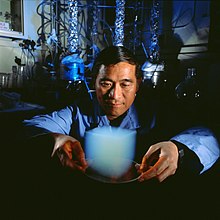- Details
- Last Updated on Thursday, 25 February 2016 08:05

 Bill + Melinda Gates on nearest future
Bill + Melinda Gates on nearest future
https://www.linkedin.com/pulse/bill-gates-just-wrote-rallying-cry-clean-energy-enough-daniel-roth
Concerning Bill's attitude to energy with eliminated carbon (dioxide), CO2, he should consider the geological past of our planet: the tropical climate was definitely not caused by human-made carbon (dioxide),CO2, because the humans have not yet existed. The tropical climate had to be caused by other factors, perhaps by volcanic carbon dioxide, but also by methane from ocean floor, swamps etc., and/or by increased Sun activity.
Charging USB-devices (mobiles, notebooks etc.) — by hydrogen fuel cell
A British company http://intelligent-energy.com has developed an always available electricity source for charging USB devices, such as mobiles, notebooks etc.. One may order it at about 150€ in the U.S.A.
Electrical signals dictate optical properties
http://www.spacemart.com/reports/Electrical_signals_dictate_optical_properties_999.html
Real-Time Pulse Monitor Using Facial Imaging
http://www.fujitsu.com/global/news/pr/archives/month/2013/20130318-01.html
Fujitsu Laboratories has developed a technology that detects a person's pulse by measuring variations in the brightness of the person's face caused by the flow of blood. It is based on the characteristic of blood hemoglobin, which absorbs green light. It requires no special hardware and can measure pulse rate simply by pointing a camera at a person's face for as little as five seconds. It also automatically chooses moments when the person's body and face are relatively still to minimize the effects of irrelevant data on measurements. This technology has a wide range of potential uses, including health monitoring and maintenance as well as security applications.
Details of this technology will be presented at the 2013 General Conference of the Institute of Electronics, Information, and Communication Engineers, opening March 19, 2013, in Gifu, Japan.
Warp Drives, Hyperspace Drives, or any other term for Faster-than-light Travel
http://www.nasa.gov/centers/glenn/technology/warp/warpstat.html
http://nextbigfuture.com/2012/09/harold-white-warp-field-mechanics-update.html
"Warp Drives", "Hyperspace Drives", or any other term for Faster-than-light travel is at the level of speculation, with some facets edging into the realm of science. We are at the point where we know what we do know and know what we don’t, but do not know for sure if faster than light travel is possible.
The bad news is that the bulk of scientific knowledge that we have accumulated to date concludes that faster than light travel is impossible. This is an artifact of Einstein’s Special Theory of Relativity. Yes, there are some other perspectives; tachyons, wormholes, inflationary universe, spacetime warping, quantum paradoxes...ideas that are in credible scientific literature, but it is still too soon to know if such ideas are viable.
One of the issues that is evoked by any faster-than-light transport is time paradoxes: causality violations and implications of time travel. As if the faster than light issue wasn’t tough enough, it is possible to construct elaborate scenarios where faster-than-light travel results in time travel. Time travel is considered far more impossible than light travel.
Neutrino - NOT faster than light (click)
OPERA
The scientists involved didn’t just accept the results, however. The most likely explanation for the super-fast neutrinos is some kind of error in the system. The team checked everything, but turned up no mistakes, which now means they are throwing it open to the wider community and asking what could have caused this anomaly. If no explanation is found, then we may have just seen proof of faster than light travel.
For the moment, the team at CERN and Gran Sasso are keeping their minds open to both possibilities, but expecting that some kind of error will be found.
The Fermilab in Chicago team had similar faster-than-light results in 2007, but those came with a giant margin of error that undercut its scientific significance.
Still a mistake...
Now, John P. Costella (Melbourne, Australia) explains why the statistical calculation is wrong (click).
TACHYON(ic particle) — faster than light

A solid as light as the air
http://stardust.jpl.nasa.gov/tech/aerogel.html | http://en.wikipedia.org/wiki/Aerogel
Aerogel is not like conventional foams, but is a special porous material with extreme microporosity on a micron scale. It is composed of individual features only a few nanometers in size. These are linked in a highly porous dendritic-like structure.



This exotic substance has many unusual properties, such as low thermal conductivity, refractive index and sound speed - these properties cause its exceptional ability to capture fast moving dust. Aerogel is made by high temperature and pressure-critical-point drying of a gel composed of colloidal silica structural units filled with solvents.
Jet Propulsion Laboratory (JPL) prepared and flight qualified aerogel. JPL also produced Aerogel with well-controlled properties and purity for the Mars Pathfinder and Stardust missions. This particular JPL-made silica aerogel approaches the density of air. It is strong and easily survives launch and space environments. JPL aerogel capture experiments have flown previously and been recovered on Shuttle flights, Spacelab II and Eureca.
CO2 Exothermic Reaction — used for novel materials
http://www.mse.mtu.edu/faculty/yunhangh.html
http://pubs.acs.org/doi/abs/10.1021/jp205499e
ABSTRACT: The conversion of CO2 to valuable compounds, which is considered as an effective approach to solve the global warming, represents a great challenge due to the high stability and low reactivity of CO2. Thermodynamic calculations predicted the feasibility of exothermic reactions between CO2 and Li3N into two important solid materials—carbon nitride and lithium cyanamide. Furthermore, the feasibility was confirmed by experiments, namely, the fast reaction between CO2 and Li3N produced crystal lithium cyanamide and amorphous carbon nitrides. This provides a novel process to control CO2 emissions.

